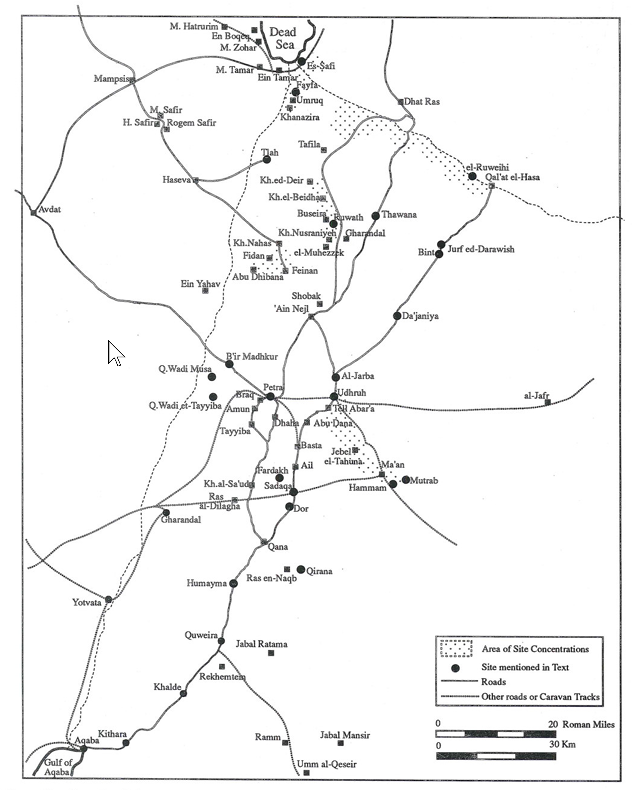Augustopolis in Palaestina
| Transliterated Name | Language | Name |
|---|---|---|
| Augustopolis in Palaestina | Latin | |
| Adhruh, Udhruh | Arabic | اذرح |
| Adrou | Greek | Άδρου |
- from Chat GPT 4o, 6 June 2025
- Sources: Wikipedia: Augustopolis in Palaestina, Wikipedia: Adhruh, Wikipedia: Petra, Wikipedia: Via Nova Traiana, Pleiades: Augustopolis, Bowersock (1983) Roman Arabia Harvard University Press
- from Chat GPT 4o, 6 June 2025
- Sources: Wikipedia: Augustopolis in Palaestina, Wikipedia: Adhruh, Wikipedia: Via Nova Traiana, Pleiades: Augustopolis
- Fig. 1 Roman-Byzantine
Southern Jordan from Fiema (1995)

 Figure 1
Figure 1
Roman-Byzantine Southern Jordan
Fiema (1995)
- Fig. 1 Roman-Byzantine
Southern Jordan from Fiema (1995)

 Figure 1
Figure 1
Roman-Byzantine Southern Jordan
Fiema (1995)
- Fig. 2 Oblique Aerial
Photograph from Danah, F.A.B et al. (2010)

 Figure 2
Figure 2
Oblique aerial photograph of the excavation area, taken by D. Kennedy in 2009
APAAME_20090930_ DLK-0299
Danah, F.A.B et al. (2010) - Augustopolis in Palaestina in Google Earth
- Fig. 2 Oblique Aerial
Photograph from Danah, F.A.B et al. (2010)

 Figure 2
Figure 2
Oblique aerial photograph of the excavation area, taken by D. Kennedy in 2009
APAAME_20090930_ DLK-0299
Danah, F.A.B et al. (2010) - Augustopolis in Palaestina in Google Earth
- from Chat GPT 4o, 6 June 2025
- summarized by ChatGPT version 4o
| Phase | Period | Date | Description |
|---|---|---|---|
| I | Nabataean | pre-106 CE | No architecture in situ. Ceramic sherds and reused elements suggest pre-Roman Nabataean presence in the earliest fills. |
| II | Roman Military | 2nd–4th century CE | Construction of castellum with corner towers and barracks. Ashlar masonry walls; Roman coarse wares and amphorae present. Lowest defined occupation layer. |
| III | Byzantine | Late 4th–6th century CE | Conversion of fort to domestic and religious use. Presence of a church-like structure, room additions, Christian graffiti, plastered floors. Late Roman and Byzantine ceramics. |
| IV | Umayyad/Early Islamic | 7th–8th century CE | Light reuse of spaces, possible squatters or short-term occupation. Islamic-period ceramics found in secondary contexts. No new major construction. |
| V | Post-Occupation/Abandonment | Post–8th century CE | Collapse debris and erosion layers fill interior spaces. No structural activity. Surface finds suggest minor Ottoman or recent visitation. |
Abudanah, F., Shqiarat, M., & Al-Muheisen, Z. (2010) The 2008 Excavations at Udhruh, ADAJ 54: 35–44
Danah, F.A.B et al.(2010) The Second Season Of Excavations At Udhru Preliminary Report , ADAJ 54
Fiema, Z. T. (1995). Military Architecture and "Defense" System in Roman-Byzantine Southern Jordan. A Critical Appraisal of Recent Interpretations . In Studies in the Archaeology and History of Jordan (Vol. 5, pp. 261-270). Department of Antiquities of Jordan.
- from Chat GPT 4o, 6 June 2025
- summarized by ChatGPT version 4o
| Phase | Period | Date | Description |
|---|---|---|---|
| I | Nabataean | pre-106 CE | No architecture preserved; Nabataean pottery and building stones reused in Roman contexts suggest pre-Roman occupation. |
| II | Roman Military | 2nd–4th century CE | Construction of rectangular fort with standard Roman layout. Part of a regional military network along the Via Nova Traiana. Fort dominates Udhruh’s early built environment. |
| III | Late Roman–Byzantine | Late 4th–6th century CE | Reuse and modification of fort for religious and civilian use. Some continued military presence likely. Christian symbols, reused materials, and modified plans attest to new function. |
| IV | Umayyad | 7th–early 8th century CE | Reduced occupation or reuse of older structures. No large-scale construction. Activity mostly inferred from ceramic scatter and reuse layers. |
| V | Abbasid and Later | Post–750 CE | Abandonment. Structures fall into disrepair and site depopulates. Some evidence for short-term pastoral or transient use in later periods. |
Abudanh, F. (2006) Settlement Patterns and Military Organisation in the Region of Udhruh (southern Jordan) in the Roman and Byzantine Periods, PhD Thesis, University of Manchester
Wikipedia: Udhruh
Wikipedia: Via Nova Traiana
As there is extensive archaeoseismic evidence from the Southern Cyril Quake of 363 CE in nearby Petra, it can be expected that Augustopolis in Palaestina was also damaged during this earthquake.
Abudanah, F. (2004) The Archaeological Survey for the Region of Udhruh, 2003 (Preliminary Report), ADAJ 48: 51–70
Abudanh, Fawzi (2006) Settlement Patterns and Military Organisation in the Region of Udhruh (southern Jordan) in the Roman and Byzantine Periods
, PhD Dissertation Newcastle upon Tyne University
Abudanah, F., Shqiarat, M., & Al-Muheisen, Z. (2010) The 2008 Excavations at Udhruh, Annual of the Department of Antiquities of Jordan 54: 35–44
Bowersock (1983) Roman Arabia Harvard University Press
Danah, F.A.B et al.(2010) The Second Season Of Excavations At Udhru Preliminary Report
, ADAJ 54
Driessen, M., & Abudanah, F. (2019) The Udhruḥ Intervisibility: Antique Communication Networks in the Hinterland of Petra, Studies in the History and Archaeology of Jordan 13: 453–473
Driessen, M., & Abudanah, F. (2018) The Udhruh region: A green desert in the hinterland of ancient Petra in
Water Societies and Technologies from the Past and Present, UCL Press
Driessen, M., & Abudanah, F. (2023) Archaeological Project Sheds Light on Ancient Water Management in Udhruh, The Jordan Times
Fiema, Z. T. (1995). Military Architecture and "Defense" System in Roman-Byzantine Southern Jordan. A Critical Appraisal of Recent Interpretations
. In Studies in the Archaeology and History of Jordan (Vol. 5, pp. 261-270). Department of Antiquities of Jordan.
Killick, A. (2001) The Water Supply Systems in the Region of Udhruh, SHAJ 9: 485–496
Musil (1907) Arabia Petraea II: Edom
Kaiserliche Akademie der Wissenschaften
